|
||||||||||
|
|
||||||||||
|
||||||||||
|
|
||||||||||
The heart of a missile is the body, equivalent to the fuselage of an aircraft. The missile body contains the guidance and control system, warhead, and propulsion system. Some missiles may consist of only the body alone, but most have additional surfaces to generate lift and provide maneuverability. Depending on what source you look at, these surfaces can go by many names. In particular, many use the generic term "fin" to refer to any aerodynamic surface on a missile. Missile designers, however, are more precise in their naming methodology and generally consider these surfaces to fall into three major categories: canards, wings, and tail fins.

The example shown above illustrates a generic missile configuration equipped with all three surfaces. Often times, the terms canard, wing, and fin are used interchangeably, which can get rather confusing. These surfaces behave in fundamentally different ways, however, based upon where they are located with respect to the missile center of gravity. In general, a wing is a relatively large surface that is located near the center of gravity while a canard is a surface near the missile nose and a tail fin is a surface near the aft end of the missile.
Most missiles are equipped with at least one set of aerodynamic surfaces, especially tail fins since these surfaces provide stability in flight. The majority of missiles are also equipped with a second set of surfaces to provide additional lift or improved control. Very few designs are equipped with all three sets of surfaces.
We have discussed how aircraft use control surfaces to turn the plane in different directions in a number of previous questions (see parts of an aircraft, origins of control surfaces, and adverse yaw). Whereas most aircraft have fixed horizontal and vertical tails with smaller movable rudder and elevator surfaces, missiles typically use all-moving surfaces, like those illustrated below, to accomplish the same purpose.
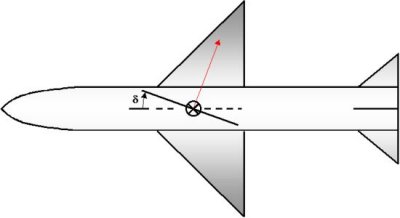
In order to turn the missile during flight, at least one set of aerodynamic surfaces is designed to rotate about a center pivot point. In so doing, the angle of attack of the fin is changed so that the lift force acting on it changes. The changes in the direction and magnitude of the forces acting on the missile cause it to move in a different direction and allow the vehicle to maneuver along its path and guide itself towards its intended target. An example of a control surface deflection on an AIM-9M Sidewinder model is illustrated below.

Canards, wings, and tails are often lumped together and referred to as aerodynamic controls. A more recent development in missile maneuvering systems is called unconventional control. Most unconventional control systems involve some form of thrust vector control (TVC) or jet interaction (JI).
We have now introduced four major categories of missile flight control systems--tail control, canard control, wing control, and unconventional control--so let's briefly take a closer look at each type.

Tail Control:
Tail control is probably the most commonly used form of missile control, particularly for longer range air-to-air missiles like AMRAAM and surface-to-air missiles like Patriot and Roland. The primary reason for this application is because tail control provides excellent maneuverability at the high angles of attack often needed to intercept a highly maneuverable aircraft. Missiles using tail control are also often fitted with a non-movable wing to provide additional lift and improve range. Some good examples of such missiles are air-to-ground weapons like Maverick and AS.30 as well as surface-to-surface missiles like Harpoon and Exocet. Tail control missiles rarely have canards, although one such example is AIM-9X Sidewinder. A selection of 23 representative missiles using tail control is pictured below.
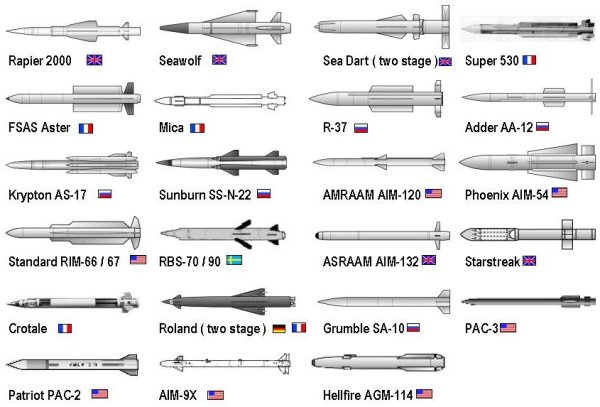
In addition to missiles, some bombs also use tail control. An example is the JDAM series of GPS-guided bombs.
Canard Control:
Canard control is also quite commonly used, especially on short-range air-to-air missiles like AIM-9M Sidewinder. The primary advantage of canard control is better maneuverability at low angles of attack, but canards tend to become ineffective at high angles of attack because of flow separation that causes the surfaces to stall. Since canards are ahead of the center of gravity, they cause a destabilizing effect and require large fixed tails to keep the missile stable. These two sets of fins usually provide sufficient lift to make wings unnecessary. Shown below are twelve examples of canard control missiles.
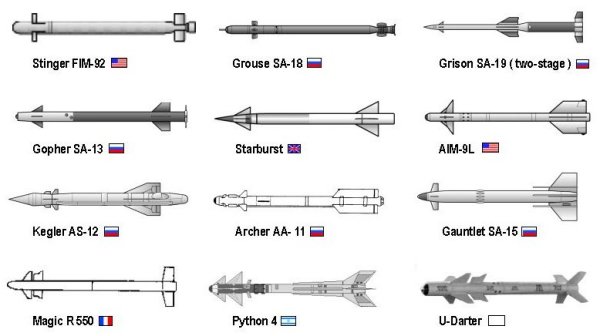
A further subset of canard control missiles is the split canard. Split canards are a relatively new development that has found application on the latest generation of short-range air-to-air missiles like Python 4 and the Russian AA-11. The term split canard refers to the fact that the missile has two sets of canards in close proximity, usually one immediately behind the other. The first canard is fixed while the second set is movable. The advantage of this arrangement is that the first set of canards generates strong, energetic vortices that increase the speed of the airflow over the second set of canards making them more effective. In addition, the vortices delay flow separation and allow the canards to reach higher angles of attack before stalling. This high angle of attack performance gives the missile much greater maneuverability compared to a missile with single canard control. Six examples of split canard missiles are shown below.

Many smart bombs also use canard control systems. Most notable of these are laser guided bombs such as the Paveway series.
Wing Control:
Wing control was one of the earliest forms of missile control developed, but it is becoming less commonly used on today's designs. Most missiles using wing control are longer-range missiles like Sparrow, Sea Skua, and HARM. The primary advantage of wing control is that the deflections of the wings produce a very fast response with little motion of the body. This feature results in small seeker tracking error and allows the missile to remain locked on target even during large maneuvers. The major disadvantage is that the wings must usually be quite large in order to generate both sufficient lift and control effectiveness, which makes the missiles rather large overall. In addition, the wings generate strong vortices that may adversely interact with the tails causing the missile to roll. This behavior is known as induced roll, and if the effect is strong enough, the control system may not be able to compensate. A few examples of wing control missiles are shown below.
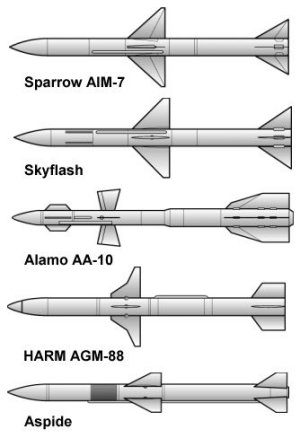
Unconventional Control:
Unconventional control systems is a broad category that includes a number of advanced technologies. Most techniques involve some kind of thrust vectoring. Thrust vectoring is defined as a method of deflecting the missile exhaust to generate a component of thrust in a vertical and/or horizontal direction. This additional force points the nose in a new direction causing the missile to turn. Another technique that is just starting to be introduced is called reaction jets. Reaction jets are usually small ports in the surface of a missile that create a jet exhaust perpendicular to the vehicle surface and produce an effect similar to thrust vectoring.
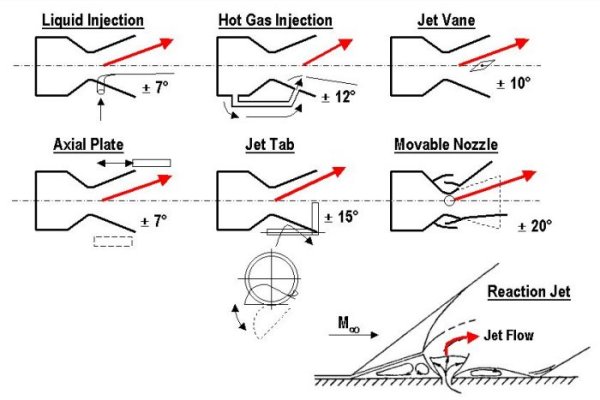
These techniques are most often applied to high off-boresight air-to-air missiles like AIM-9X Sidewinder and IRIS-T to provide exceptional maneuverability. The greatest advantage of such controls is that they can function at very low speeds or in a vacuum where there is little or no airflow to act on conventional fins. The primary drawback, however, is that they will not function once the fuel supply is exhausted.
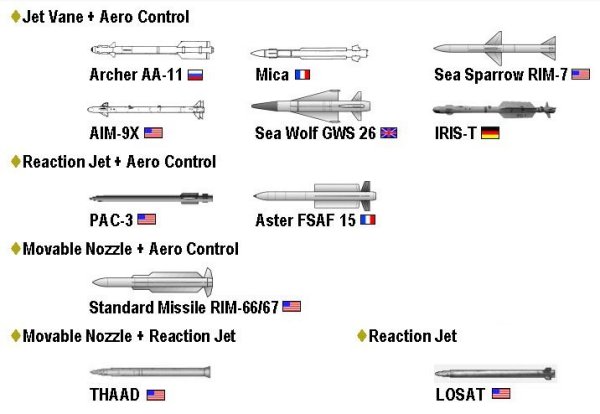
Examples of missiles employing unconventional controls are shown above. Note that most missiles equipped with unconventional controls do not rely on these controls alone for maneuverability, but only as a supplement to aerodynamic surfaces like canards and tail fins.
Other Options:
Finally, it should be noted that some missiles do exist that use conventional controls similar to those employed
by aircraft. These systems are usually referred to as bank-to-turn controls since the missile banks much like
an airplane would. Most weapons employing such controls are cruise missiles like Tomahawk and ALCM.
- answer by Jeff Scott, 11 January 2004
Related Topics:
Can you explain the types of guidance systems used in missiles?
What is the difference between a missile and a rocket or a bomb, a cluster bomb, and a guided bomb?
Read More Articles:


|
Aircraft | Design | Ask Us | Shop | Search |

|
|
| About Us | Contact Us | Copyright © 1997-2023 | |||
|
|
|||